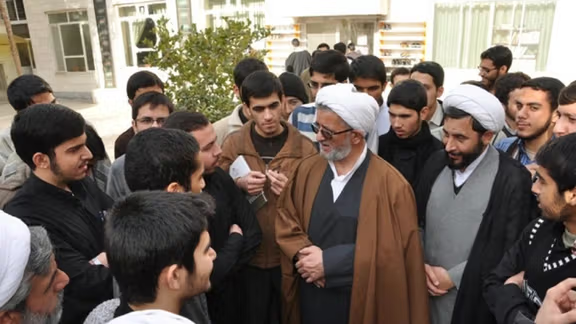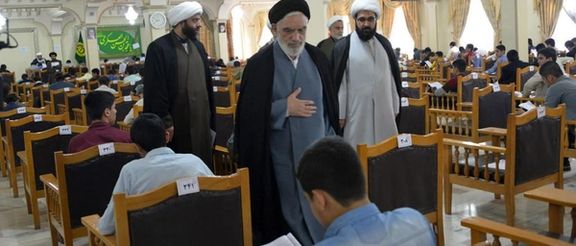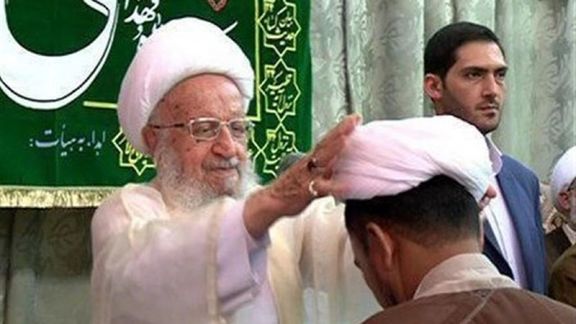The Lives Of Iran's Shiite Clerics - Studying In A Seminary

This article is the first in a series about Iran’s Shiite clerics, explaining how they study, get a clerical rank, get married and what they do for a living.

This article is the first in a series about Iran’s Shiite clerics, explaining how they study, get a clerical rank, get married and what they do for a living.
-----------------------------------------------------------------------------------------------------------------------------
Before clerics came to power in Iran in 1979, mullahs as we know them in the West, or akhunds as they were called in Iran, used to solemnize marriages, tell stories about the martyrdom of the 12 imams to set the stage for the pious villagers and small-town dwellers to weep, or to recite verses from the Koran to usher the dead into paradise.
Some say the Islamic revolution was in fact a revolt that brought fundamentalist clerics to power, who often had no professional training or academic background for the government positions they later occupied.
Iranians and Iran watchers might remember that during the televised debates among presidential candidates in 2021, one candidate revealed that Ebrahim Raisi, who eventually won the election, had been to regular school for only six years. Now, he must make modern-day economic decisions, meet and interact with foreign leaders and run a huge bureaucracy.
Seyyed Ahmad Bathaei, born in 1987, studied at the Qom Seminary and is now a Ph.D. candidate in Philosophy and at the same time works as deputy dean at the Islamic Art Institute. "All of us have quit official schooling at one point to join the seminary and become a renowned scholar. I never know what it was I wanted to do to earn a living. As a young man, I had no dream, no future. But life grabs you by the neck at one point and makes you decide," he says.
"Many of my friends thought I would be a cleric like my dad. But my father left it to me to decide. He said: 'He can do anything he wants to do. No pressure.' I finally made the decision after nine years at a normal school. I applied for studying at the seminary. On the exam day I was so nervous I threw up on my papers. When the results came out and I passed the exam, I did not know exactly how to feel. I was amazed, happy, and at the same time helpless. I was not ready for the challenge. My father once again left me to decide for myself to continue at grade 10 at a normal school or to start from the scratch at the seminary," Bathaei remembers.
"When he found me undecided, he said that I could go to the seminary, complete the clerical studies and then continue my "normal" education to become a doctor or an engineer. In fact, in those days there was a cleric in Qom who was a medical doctor. So, what my dad said could be true. And I chose to become an akhund, an Iranian Shiite cleric," he maintains.

According to Bathaei, seminary teachers prefer students who come to Qom as a younger man because their character is still not rigid and they can shape it in the 'right' way. The seminary starts after an interview to assess your character and the classes start in September. The best students end up at one of Qom's 24 madrassahs.
Courses start with minimal Arabic grammar and continue with elementary Islamic ideology and the attestations of big scholars on various matters of everyday life. The clerics have to learn the Arabic to be able to read the textbooks, but very few learn even a basic Arabic.

After classes during which a teacher lectures the basics, the students get together, often in groups of three to discuss what they have learned. One of them repeats the teacher's lecture and the other two keep asking questions. Every day, there are usually four one-hour lectures followed by four discussions. At the beginning, all the students wish to be a Seghat ul-Islam or a learned scholar of Islam, but many end up becoming a simple cleric.
The muqaddamat (introductory) and the sat’h (advanced) levels continue for about six years. Many stop at the introductory level, but still they are believed to have turned from seminary students to clerics. That is when they get their robe (aba) and turban (ammameh) from their teacher. The costume is supposed to make the clerics look like the prophet. At this stage, the clerics become Hojjat ul-Eslam. They can no longer go out in jeans and T-shirts. Their behavior should show their dignity.
Nontheless, after the Islamic revolution, many clerics have chosen to be "amphibious" which means they can separate their daily life as clerics or as laymen and choose what they wear at different times. Former presidential adviser Hesamoddin Ashna and former vice-president Mohammad Nahavandian are examples of such clerics. They appear both in clerical garb and in Western suits.
To become an ayatollah, the Hojjat ul-Eslam needs to take at least another two or three advanced courses (dars-e kharej). The title has nothing to do with politics. Many clerics like to be called ayatollahs and in fact many do call them as such. But influential clerics such as Ayatollah Ali Khamenei do not buy that and refuse to call those clerics ayatollah and simply refer to them as "Hojjat ul-Eslam".An ayatollah who can teach the dars-e kharej, and does it for several years, may become an ayatollah ul-ozma (grand ayatollah). Out of a thousand clerics, a few can become ayatollahs and perhaps only one or two will become as high-ranking as a grand ayatollah.